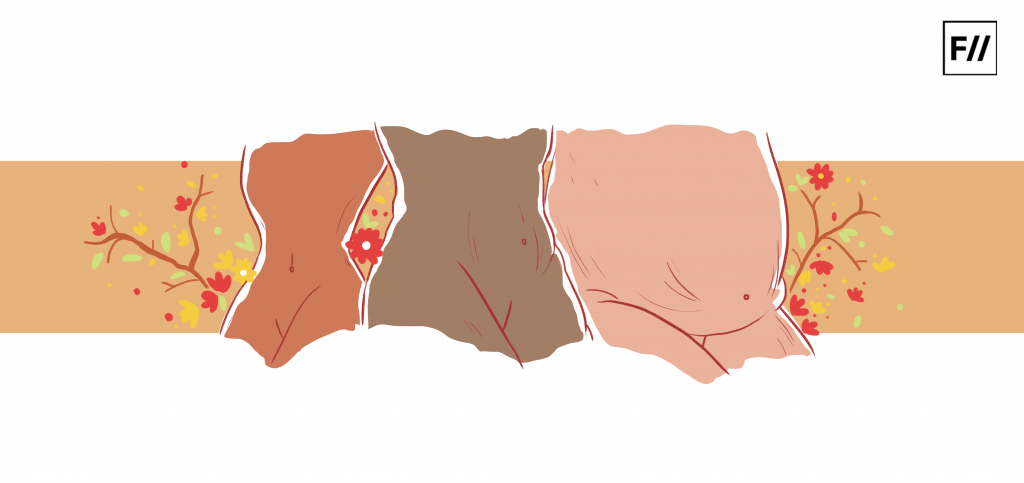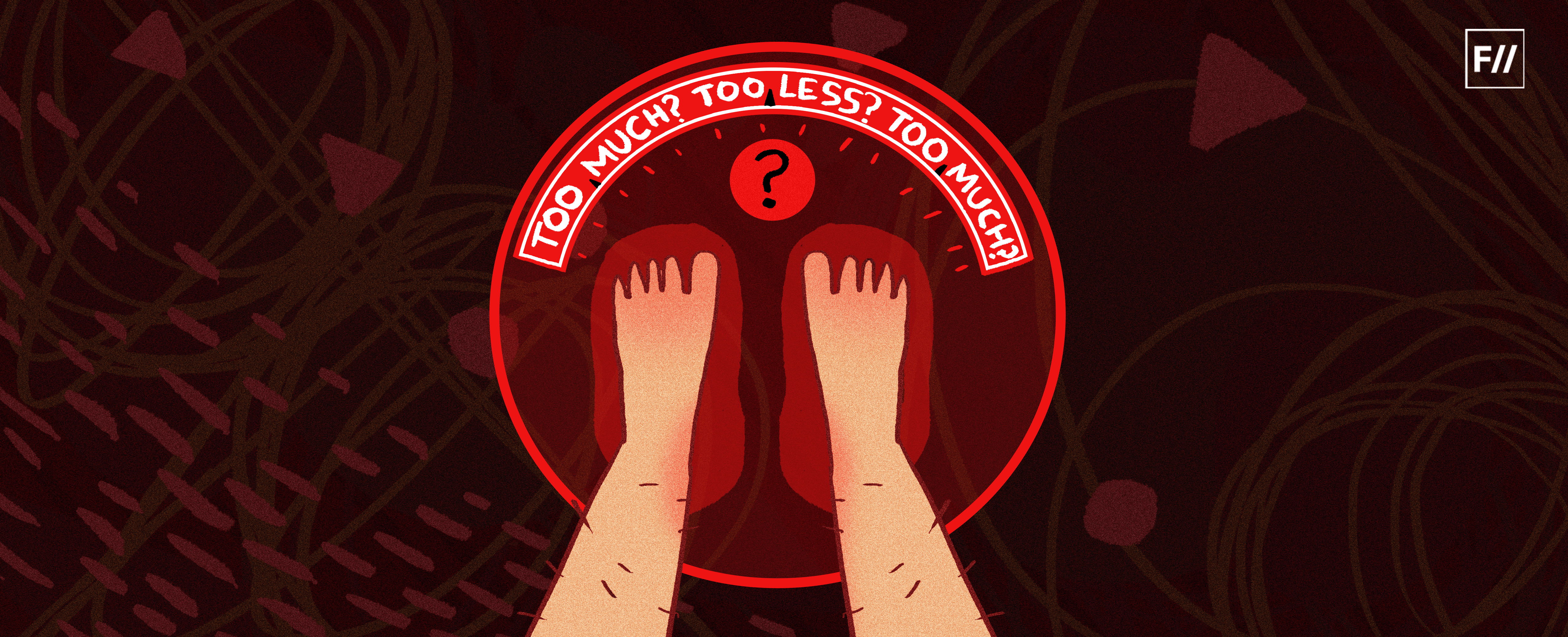Sitting in the doctor’s office, as I awaited an explanation for the cause of my severe period cramps, I anticipated the usual advice: “You need to lose weight.” The string of four words was not new to my fifteen-year-old self. This time too, I was not left disappointed. It was almost as if every answer to every medical problem I had back then was only weight loss and physical activity.
(I use the word ‘fat’ here to describe myself and other people as a neutral descriptor of our bodies and try to move away from the negative cultural connotations attached to the word.)

You lose weight, you will become healthier, fitter and better. This summarises the entire plotline of the American TV show – The Biggest Loser, which celebrates drastic weight loss stories by forcing people to undergo extreme diets, workouts and become sources of inspiration for people to lose weight. People who lost weight (read forced) were reduced to before and after photos wherein it was always the ‘after’ that brought more worth, joy and accolades while the ‘before’ was constantly used as a reminder to tell people to not be that ever again. The contestant that loses the most kilos of weight becomes the ‘biggest loser’.
Contestants on the show have gone on record to expose the damage unleashed on their bodies by such extreme weight loss. A report from The Atlantic presented interviews with different contestants through the seasons to highlight the toxic environment of the show. Season 1 winner, Ryan Benson in an interview to New York Times said that by the finale, due to his extreme diet, he was urinating blood. Another contestant from season 3 mentioned how she lost a huge amount of weight by consuming sugar free Jell-o and sweated out more fat in the sauna. One must note here is that all this continued even under the supervision of trained medical professionals and doctors under whose guidance weight loss plans were devised.
Influential medical organisations such as the World Health Organisation (WHO) and the National Institutes of Health (NIH) have long used the Body Mass Index (BMI) to classify people into different categories. The BMI has over the years not only been standardised as a measure for weight due to its simple and inexpensive method but also been used as a tool to pathologize, stigmatise and subsequently marginalise people in fatter bodies.
Weight Watchers (now rebranded as WW), the famous weight loss company, for example, provides tailor-made weight loss plans in the form of diets, fitness plans and more recently through its “wellness programs” provides a more holistic approach . User testimonies on its website show how weight loss was a positive force in their lives. Like The Biggest Loser, the company vilifies fatness and pushes people towards weight loss to become better versions of themselves.
How do medical professionals then deem if you are someone who must lose weight and become thinner or else you will face several medical problems ahead in life or might even die due to excessive weight?
Revisiting The Racist History Of BMI
Influential medical organisations such as the World Health Organisation (WHO) and the National Institutes of Health (NIH) have long used the Body Mass Index (BMI) to classify people into different categories. The BMI has over the years not only been standardised as a measure for weight due to its simple and inexpensive method but also been used as a tool to pathologize, stigmatise and subsequently marginalise people in fatter bodies.
Dr Sabrina Strings in her seminal work, Fearing the Black Body: The Racial Origins of Fatphobia minutely charts out the historical events that led to the standardisation of the BMI. She explains how medical knowledge combined with racist and eugenicist ideas prevalent through the late 19th and early 20th century in the United States of America fuelled the idea that the fatter, black body (especially those of black women) was inherently “primitive” and “gross” and racially inferior. Consequently, they were stigmatised and oppressed by the medical sciences.
While we are slowly waking up to the racist origins of the BMI and pinpointing its source to the Belgian academic, Adolphe Quetelet, we are in fact forgetting a very important figure who was pivotal in bringing back the index that Quetelet had formulated in the 1800s and standardising it as the BMI. Ancel Keys, a doctorate in biology and physiology, was keen on devising a method to measure overweight and obesity in people across populations. As Sabrina Strings notes, he was famous for the Seven Nations Study, a study to examine the link between diet, weight and heart diseases. In fact, much later after his study, Keys is said to have claimed that obesity did not necessarily cause heart diseases.
However, he also maintained that obesity was “unsightly”, “disgusting” and repugnant”. In Quetelet’s Index, Keys found a way to measure obesity and renamed it the Body Mass Index despite encountering the same question Quetelet faced nearly a century ago: variations in body compositions do not follow the normal curve. In 1972, Keys and his team published their famous paper which called for the use of the BMI as a tool to measure obesity (even if it only measured the individual’s relative weight, as observable from their first paper). Despite the inherent flaws, Keys and his team recommended its use to measure body fat, not because of its accuracy or validity but only because it was a simpler, easier way than skinfold tests or body density tests.
Also read: The ‘Second Druggies’ – The Double Oppression That Female Drug Addicts…
So how was the BMI popularised?
As mentioned above, the key medical institutions in the United States namely the NIH, CDC and WHO were instrumental in propagating its usefulness newly established BMI. The National Institutes of Health (NIH) were the first to implement Keys’ BMI in 1985. The World Health Organisation also followed suit. In 1995, the WHO’s report on obesity used the BMI to assign values for overweight and obesity in people stating that the values of 25, 30 and 40 are an “arbitrary method of association between the BMI and mortality” as Sabrina Strings mentions. Gender, age, race, body composition were unaccounted for while establishing these numbers.
The historical trajectory charted above is a small glimpse into the much larger, complex history of the BMI that stretches across several centuries. One cannot look at its history without scrutinising the fatphobia, racism, sexism and colonialism that is rife in the medical sciences. As Sabrina Strings highlights, the “fat black woman” was viewed not only as ‘savage’ or ‘barbarous’, she was also deemed ‘diseased’ by the medical sciences.
While initially, the NIH and WHO maintained that these numbers must be viewed with caution, this was abandoned by the late 1990s and the range for normal weight had also shrunk. Those who were of a “normal weight range” became “overweight” overnight. The new classifications of the BMI were as follows: Underweight: ≤ 18.4; Normal weight: 18.5 – 24.9; Overweight: 25-29.9; Obese class 1: 30-34.9; Obese class 2: 35-39.9; extremely obese ≥ 40. The WHO Expert Consultation in 2004 also suggested using different BMI cutoffs for Asian populations as they believed that Asians were at a higher risk of diabetes and cardiovascular diseases at a lower BMI (precisely 22 kg/m2 instead of 25 kg/m2).
However, in their recommendations they insisted on keeping the internationally used BMI cut-offs intact but also to add trigger points in between ranges to identify a higher risk of diseases in populations – as the BMI of an individual increased, their risk of suffering from multiple fatal diseases and mortality also rises.
The historical trajectory charted above is a small glimpse into the much larger, complex history of the BMI that stretches across several centuries. One cannot look at its history without scrutinising the fatphobia, racism, sexism and colonialism that is rife in the medical sciences. As Sabrina Strings highlights, the “fat black woman” was viewed not only as ‘savage’ or ‘barbarous’, she was also deemed ‘diseased’ by the medical sciences. This not only marginalised her racially but also subjugated her body for not fitting into the “thin ideal” of the white woman. One cannot look at BMI without looking at fatphobia and anti-fatness. And one cannot separate fatphobia from the inherent racism it perpetuates.

Conclusion
The role of NIH and WHO among other influential institutes of medical sciences in standardising the BMI to become a signifier of health has gained traction in the recent past. The “war on obesity”, “the obesity epidemic”, “globesity”, “the terror within” are some of the recent catch-phrases that demonize obesity and thereby, fat and obese people. As the “war” gets waged on fat and obese people to reduce weight to become “healthier”, the use of the BMI to measure their “unhealthiness” solidifies and furthers the notion that there exists a “normal range” of the BMI.
Falling beyond this range would lead to stigmatisation and legitimise what many fat activists call “concern trolling”, wherein people who advise others to lose weight by passing seemingly innocuous comments directed at the one’s appearance or dietary habits, often defend their comments by saying it was only directed at the health and well-being of the individual.
When the medical sciences use this weight-centred approach towards healthcare by centring the BMI, it perpetuates the harmful intersections of fatphobia, medical racism and sexism and treats the fatter, obese body as something that can be hammered into a narrow definition of the “normal”, be it weight, health or BMI. Moving away from this BMI-centric approach and adopting a more inclusive way to look at healthcare is the way forward and this would thus require holding the medical sciences accountable for its continued oppression and marginalisation of fat folx in the past and the present.
Also read: The BMI Is Not As Heavy-Weight As We Think It Is
References
- Fearing the black body: The racial origins of fat phobia. NYU Press.
- Whose voice counts? A critical examination of discourses surrounding the body mass index
- “Healthism and the bodies of women: Pleasure and discipline in the war against obesity.”
- Fitness and Health Are Not the Same (No Matter What Fatphobia Attempts to Claim). Everyday Feminism
- Weight Stigma Is a Dangerous Threat to Health. Medium. (2020).
Pooja (she/her) is a social sciences student who’s hoping to foray into gender and sexuality studies and is striving to make the world more size-inclusive and fat-accepting. Her Bachelors thesis focused on how popular media and medical sciences interact to stigmatise fat bodies and perpetuate fatphobia by continuously making thin bodies as the ideal type. She enjoys reading and clicking pictures and she has recently ventured into using art and painting as a form of self-expression. At other times, she can be found watering her plants or hunting for containers to propagate them. You can reach her at poojanarayan2@gmail.com or on her Instagram.
Featured Image Source: Feminism In India




